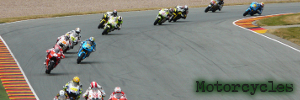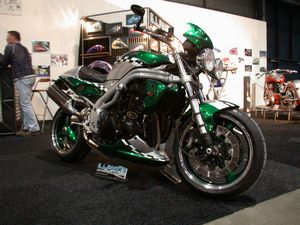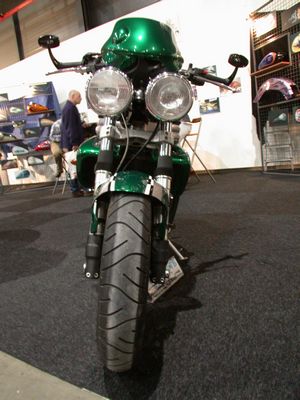















Triumph |
|---|

|
| Topic Navigation |
|---|
|
Wikipedia: Triumph Motor Company
Wikipedia: Triumph Motorcycles Ltd Page Sections History Photographs Article Index |
History
The following section is an excerpt from Wikipedia's Triumph Motor Company page on 21 November 2015, text available via the Creative Commons Attribution-ShareAlike 3.0 Unported License.
The Triumph Motor Company was a British car and motor manufacturing company. The Triumph marque (trade-name) is owned currently by BMW. The marque had its origins in 1885 when Siegfried Bettmann (1863–1951) of Nuremberg formed S. Bettmann & Co and started importing bicycles from Europe and selling them under his own trade name in London. The trade name became "Triumph" the following year, and in 1887 Bettmann was joined by a partner, Moritz (Maurice) Schulte, also from Germany. In 1889 the businessmen started producing their own bicycles in Coventry, England.
History
Triumph Cycle Company
The company was renamed the Triumph Cycle Co. Ltd. in 1897. In 1902, they began producing Triumph motorcycles at their works in Coventry on Much Park Street. At first, these used engines purchased from another company, but the business prospered and they soon started making their own engines. In 1907, they purchased the premises of a spinning mill on Priory Street to develop a new factory. Major orders for the 550 cc Model H were made by the British Army during the First World War; by 1918, Triumph had become Britain's largest manufacturer of motorcycles.
In 1921, Bettmann was persuaded by his general manager Claude Holbrook (1886–1979), who had joined the company in 1919, to acquire the assets and Clay Lane premises of the Dawson Car Company and start producing a car and 1.4-litre engine type named the Triumph 10/20 designed for them by Lea-Francis, to whom they paid a royalty for every car sold. Production of this car and its immediate successors was moderate, but this changed with the introduction in 1927 of the Triumph Super 7, which sold in large numbers until 1934.
Triumph Motor Company
In 1930 the company's name was changed to Triumph Motor Company. Holbrook realized he could not compete with the larger car companies for the mass market, so he decided to produce expensive cars, and introduced the models Southern Cross and Gloria. At first these used engines made by Triumph but designed by Coventry Climax, but in 1937 Triumph started to produce engines to their own designs by Donald Healey, who had become the company’s Experimental Manager in 1934.
The company encountered financial problems however, and in 1936 the Triumph bicycle and motorcycle businesses were sold, the latter to Jack Sangster of Ariel to become Triumph Engineering Co Ltd. Healey purchased an Alfa Romeo 8C 2300 and developed a new car model with an Alfa inspired straight-8 engine type named the Triumph Dolomite. Three of these cars were made in 1934, one of which was used in competition and destroyed in an accident. The Dolomites manufactured from 1937 to 1940 were unrelated to these prototypes.
In July 1939 the Triumph Motor Company went into receivership and the factory, equipment and goodwill were offered for sale. Thomas W. Ward Ltd. purchased the company and placed Healey in charge as general manager, but the effects of the Second World War again stopped the production of cars; the Holbrook Lane works were completely destroyed by bombing in 1940.
The following section is an excerpt from Wikipedia's Triumph Motorcycles Ltd page on 21 November 2015, text available via the Creative Commons Attribution-ShareAlike 3.0 Unported License.
Triumph Motorcycles Ltd is the largest British motorcycle manufacturer; it was established in 1984 by John Bloor after the original company Triumph Engineering went into receivership. The new company (initially Bonneville Coventry Ltd) continued Triumph's record of motorcycle production since 1902. As of mid-2012, the company produced 49,000 motorcycles and employed 1,600 staff.
History
When Triumph Engineering went into receivership in 1983, John Bloor bought the name and manufacturing rights from the Official Receiver. The new company's manufacturing plant and its designs were not able to compete against the Japanese, so Bloor decided against relaunching Triumph immediately. Initially, production of the old Bonneville was continued under licence by Les Harris of Racing Spares, in Newton Abbot, Devon, to bridge the gap between the end of the old company and the start of the new company. For five years from 1983, about 14 were built a week in peak production. In the USA, owing to problems with liability insurance, the Harris Bonnevilles were never imported.
Bloor set to work assembling the new Triumph, hiring several of the group's former designers to begin work on new models. The team visited Japan on a tour of its competitors' facilities and became determined to adopt Japanese manufacturing techniques and especially new-generation computer-controlled machinery. In 1985, Triumph purchased a first set of equipment to begin working, in secret, on its new prototype models. By 1987, the company had completed its first engine. In 1988, Bloor funded the building of a new factory at a 10-acre (40,000 m2) site in Hinckley, Leicestershire. Bloor put between £70 million and £100 million into the company between purchasing the brand and breaking even in 2000.
At the same time as production capacity increased, Bloor established a new network of export distributors. He has previously created two subsidiary companies, Triumph Deutschland GmbH and Triumph France SA. In 1994, Bloor created Triumph Motorcycles America Ltd.
At 21.00 hours on 15 March 2002, as the company was preparing to celebrate its 100th anniversary as a motorcycle maker, its main factory was destroyed by a fire which began at the rear of the facility. At the height of the blaze, over 100 firefighters were tackling the fire, which destroyed most of the manufacturing capacity. Nevertheless, the company, which by then employed more than 650, quickly rebuilt the facility and returned to production by September that year.
In May 2002, Triumph began construction on a new sub-assembly manufacturing facility in Chonburi, Thailand to make various components. A second factory was opened in 2006 by Prince Andrew, Duke of York where a wet painting facility and assembly line have been established. A third factory was opened in 2007 to include high pressure die-casting and machining, and Triumph announced that they were expanding to increase capacity to over 130,000 motorcycles. Triumph Motorcycles (Thailand) Limited is a 100% UK owned company and now employs about 1000 staff.
The Triumph Group announced sales of 37,400 motorcycles in the financial year ending 30 June 2006. This represented a growth of 18% over the 31,600 produced in 2005. Company turnover (revenues) rose 13% to £200 million ($370 million), but net profit remained static at around £10.3 million due to recent investment in production facilities. In June 2009 Digby Jones, Baron Jones of Birmingham, the former Minister of State for Trade, became chairman of Triumph motorcycles (Hinckley) Ltd and the 1,600 cc (98 cu in) Thunderbird twin-cylinder cruiser was announced.
The Group turnover increased by 11% from £312.4 million in 2010 to £345.3 million in 2011 and unit sales of motorcycles increased by 7% from 45,501 to 48,684. This increase in unit sales can be largely attributed to the introduction of incremental models to the range. The operating profit before interest and tax grew from £15.1 million to £22.3 million due to strong sales of motorcycles and related products, benefitting from improved use of working capital and continued focus upon the cost base. During 2011 Triumph launched three new motorcycles: the Tiger Explorer, Speed Triple R and the Steve McQueen Special, successfully bucking the trend of the global downturn in motorcycle sales.
Photographs
The following photographs cannot be identified. If you know any details about these images, please e-mail admin@carsandracingstuff.com.
 |
Photo courtesy of Image*After
View photo of Triumph Motorcycle - 1,025KB |
 |
Photo courtesy of Image*After
View photo of Triumph Motorcycle - 1,028KB |
